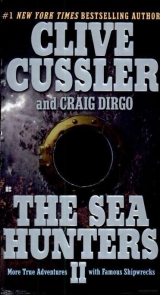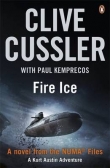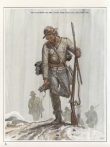
Текст книги "The Sea Hunters II: More True Adventures with Famous Shipwrecks"
Автор книги: Clive Cussler
Соавторы: Craig Dirgo
Жанры:
Прочая документальная литература
,сообщить о нарушении
Текущая страница: 16 (всего у книги 27 страниц)
Back in the city, a reporter with the Tribune called his office from police headquarters. “The excursion boat General Slocum,carrying a Sunday school group, is ablaze in the East River. Casualties will be high,” he finished.
The Tribuneeditor arranged for photographers and reporters to be sent to the scene.
Mayor McClellan paced the floors of his office in City Hall. “The police commissioner reports that he has sent all his available men to the scene,” he said to his aide. “Make sure the fire chief is pulling out all the stops, as well.”
The man started for the door.
“What’s the number for City Hospital?” McClellan shouted at the retreating man.
“Gotham 621,” the man shouted back.
McClellan reached for the telephone.
“This is the mayor,” he shouted into the phone. “Give me the head of operations.”
“Pull them across,” Wade shouted to his deckhands out of the window of the pilothouse, “then send them aft.”
Glancing toward the transom, Wade could see several blackened bodies floating close to his propellers. There was nothing he could do – he needed propulsion to stay close to the steamer and to be ready to back away at a moment’s notice. He watched as a corpse swirled in the propellers’ whirlpool, then was sucked under and shredded.
He turned back to the bow.
“Get them off there,” he screamed.
Little Germany on the Lower East Side was in chaos. Relatives of the passengers on General Slocumjammed the elevated train platforms from Fourteenth Street to First Street in an effort to board an uptown train. Rumors ran through the crowd as the tension grew. Outside St. Mark’s Church, a crowd grew large. Parents with tearstained faces awaited word of a miracle that would never come.
The captain of Zophar Millswas directing a stream of water at the burning center of General Slocum. The visible flames were gone, but the wreckage was still smoldering. The water around his fireboat was littered with the corpses of adults and children. His crew had managed to pluck nearly thirty people from the water, and they huddled on the stem deck like refugees from a violent war.
At that instant, a rumbling was heard from General Slocum,and the ship rolled to one side.
* * *
Nurse Livingston had grown numb to the suffering. The shore of North Brother Island looked like a battlefield. She no longer heard the moans of the dying – the screams of the burned and injured were much louder. Dr. Kacynski had administered the fifty doses of morphine he had brought along.
“Nurse Livingston,” he shouted over the screams, “return to the pharmacy. I need all the stores of pain medication we have available.”
“Yes, Doctor,” Livingston said.
She began jogging toward the hospital, momentarily free from the horrors.
* * *
Wade had done all he could. General Slocumwas awash, only one side of the paddle wheel and a portion of the fore deck above water. Backing away from the wreckage, he turned Easy Timesninety degrees and set off for New York City with his load of sick and injured.
The hospital on North Brother Island was filled to overflowing.
“At least five hundred, maybe a thousand,” Alderman John Dougherty reported over the telephone to Mayor McClellan.
“Good Lord,” McClellan exclaimed, “maybe there will be more survivors.”
“I don’t think so, sir,” Dougherty said. “The steamer is awash.”
“I want you to find the commander of Engine Company 35,” McClellan said.
“The fire on board is out, sir,” Dougherty said.
“I know, John,” McClellan said wearily. “I want the firemen to help the coroner to identify the bodies.”
“Yes, sir,” Dougherty said.
“I’ll send some boats across to bring the bodies back to the pier at East Twenty-sixth Street,” McClellan said. “The families of the deceased can retrieve the bodies there.”
* * *
On the East River, New York City police boats were dragging the river for bodies. By seven that evening, they had retrieved more than two hundred. It was dark when the coroner stood over another blackened body.
“Check the pockets,” he said to a fireman.
The man rolled the body over and removed a soggy leather wallet from the pocket.
“George Pullman,” the fireman said, as he stared at the name on a library card, “and there’s a check here for $300 made out to the Knickerbocker Steamboat Company.”
The coroner nodded. “I knew George,” he said quietly. “He was the treasurer of the St. Mark’s Sunday School.”
The fireman nodded.
“At least these bastards never got paid,” the coroner said angrily.
* * *
General Slocum’shold still held some air, and the ship was drifting on the current. After traveling a short distance, the hulk grounded off Hunt’s Point. A diver was sent down into the hull. He found nearly a dozen bodies trapped in the wreckage. He brought them to the surface one by one.
The last was a lad nine years old who was clutching a prayer book in his hands.
As soon as the heavy dive helmet was removed, the diver burst into sobs. As his boat made its way back to the city, the diver sat on the stem deck, alone with his thoughts. General Slocumwas his last dive ever.
* * *
Joe Flarethy, a lieutenant with the New York City Police Department, stared at the man on the stretcher at the hospital on North Brother Island with barely concealed disgust. The man’s leg had been fractured when he’d leapt from General Slocum.
“I understand you’re Captain Van Schaick,” Flarethy spat.
“I am,” Van Schaick said.
“You’re under arrest by order of the mayor,” Flarethy said. “Now, why don’t you make it easy on us and point out the rest of your crew?”
Van Schaick raised himself up on his elbows. “I’m the captain,” he said. “I’m responsible. You want to identify the crew, you do it yourself.”
Flarethy turned to the sergeant at his side. “Go bed to bed and ask the patients for identification. The seamen should have papers. Anyone that doesn’t – tag their toe and we’ll sort through them later.”
He turned back to Van Schaick.
“A real hero, aren’t you? Trying to protect your crew.” Flarethy pointed out the window toward the river. “The time to be a hero was out there.”
Van Schaick said nothing.
“Cuff this son of a bitch,” Flarethy said to a patrolman standing nearby.
* * *
“The Twenty-Sixth Street morgue is full,” Mayor McClellan said over the telephone to Dougherty. “We can’t take any more bodies.”
“Hold on,” Dougherty said.
McClellan heard snippets of conversation as Dougherty spoke to someone nearby.
“Okay, sir,” he said after a few moments, “there’s an abandoned coal shed just to the side of the hospital we can use as a makeshift morgue.”
“Excellent,” McClellan said.
“There’s just one thing,” Dougherty said.
“What’s that?” McClellan asked.
“We’ll need another boatload of ice to chill the bodies.”
“I’ll have it sent over immediately.”
* * *
There was a dim electric light illuminating the Twenty-sixth Street Pier as the first load of coffins was unloaded from the boats. Ice had been placed in the coffins to keep the bodies from decomposing, and as it melted it ran through the cracks in the wood and stained the street. Hundreds of ashen-faced parents had gathered to see if they could locate their missing children. A few survivors straggled off the boats. Most were half-dressed or slightly injured in some way. Almost all were adults. They hung their heads in shame.
Halfway up a ladder, in the center of the crowd, was a fireman from Engine Company Number 35. As the 432 caskets were carried past, he shouted out the names of the dead that had been identified. The wails from mourning parents filled the area around the pier. Those that had not been identified were stacked in neat rows waiting for space to open up at the morgue.
* * *
The morning following the disaster dawned clear and warm. Throughout New York City, flags flew at half-mast. At City Hall, Mayor McClellan learned that bodies were still washing up on the banks of the East River. He made the arrangements for collection and burial, then turned his attention to preventing another such disaster. First, he instituted a free “Learn to Swim” program. Second, he ordered all excursion boats in New York Harbor to cease operations until the vessels were checked and approved. Third, he began a full-scale investigation into the General Slocumtragedy.
When the final count was tallied, 1,021 passengers had perished.
But General Slocumwas not finished.
* * *
Diver Jackson Hall stood on the side of the hull above water and shouted across the water to the captain of the salvage ship Francis Ann. He had spent the last hour inspecting the hull, which was resting on the bottom of the East River off Hunt’s Point.
“You can pick me up now,” Hall shouted across the water.
“How’s she look?” the captain shouted back.
“She can be raised,” Hall said. “The lower hull is intact – it’s the upper decks that sustained the most damage.”
“What’s she look like inside?” the captain questioned.
“Lots of blackened wood is piled in the center,” Hall said. “I was nearly hung up twice. The boilers appeared intact but bent. The port paddle wheel is shredded from the weight of the hulk pressing down.”
“What’s the surface like below the hulk?”
“It felt like soft mud,” Hall noted.
“Then we can get straps under the hull,” the captain said.
“Yes, sir,” Hall said.
“Then we’ll come alongside to pick you up,” the captain said, as he walked back toward the pilothouse.
“Good,” Hall muttered under his breath.
His inspection of General Slocum had made him uneasy. Ghosts of a thousand souls seemed to inhabit the inner sanctum he had entered. Twice he had thought he felt arms grab for him. Once he had caught sight of what he thought was an apparition out of the comer of his faceplate. When he turned his head and glanced through the murky water, he’d realized that it was part of a canvas top covering flapping in the current. Still, Hall had been spooked. He finished his inspection in record time.
* * *
Three weeks later, General Slocum was above water once again. The burned hulk was towed to a shipyard in New Jersey, where the top decks were razed and the wreckage in the hull removed and scrapped. Over the next few weeks, the hull was converted into a barge and rechristened Maryland.
She, too, would meet with an inglorious end.
* * *
The coast off the eastern seaboard of the United States can be a dangerous place when the winds of winter whip the surface of the sea. Captain Tebo Mallick of the towboat Gestimainewas a salty dog. Thirty-seven of his fifty years on the planet had been spent at sea, and he’d learned to read the signs on the water like they were lit with spotlights. Tonight, the sea off Atlantic City, New Jersey, was no place for man nor ship. Towering waves were rolling from east to west, the tops frosted with foamy white. Sheets of cold rain rattled the pilothouse windows like sand shot from a cannon. He stared toward land.
“I can barely see the lighthouse,” he said to a cat that lay atop the chart desk.
Then he swiveled and tried to look astern. Somewhere in the fog, a hundred yards to the rear and attached to his ship by a thick hemp line, was a barge loaded with furnace coke named Maryland.At just that second, a wave broke over his bow as the door to the pilothouse opened. The light from the brass fuel oil lamp hanging from the ceiling flickered and almost went out.
“I think the barge is taking on water,” deckhand Frank Terbill shouted.
Mallick twisted the wheel of Francis Ann as the weight from the barge pulled his stern toward the waves.
“She’s been porpoising for the last half hour,” Mallick said. “I was hoping the seas would calm some.”
Mallick felt his engine surge as the line connecting Maryland to his stern slackened.
“She’s going to whipsaw,” Mallick managed to shout to Terbill, before a wave hit Francis Annbroadside and threw them both against the bulkhead.
Then one of the lines connecting them to Maryland parted. It whipped over the pilothouse like an angry snake and snapped against the windshield. Francis Ann was pulled to port as the weight shifted and Mallick struggled to keep her from facing abeam to the mounting waves. Grabbing an ax mounted on the wall, he handed it to Terbill.
“Cut that bitch loose,” he shouted, “or we’re going in.”
Terbill raced to the stem deck and raised the ax over his head. Then he swung with all the force he possessed. The blade parted the line and embedded itself in the gunwale. In the fog, no one witnessed Marylandgo under.
II
Coke Isn’t Necessarily a Soft Drink 1994, 2000
In 1987, Bob Fleming, my old friend and researcher, sent me a report from the Army Corps of Engineers on the sinking and later demolition of a barge called the Maryland. At first I failed to see the significance of a lost barge, but then he called me on the phone and explained that Maryland was the ill-fated excursion steamboat General Slocum that had burned in New York’s East River in the summer of 1904 with horrible loss of life.
Sometime after the burned-out hulk had grounded on Brother’s Island in the East River, she was raised and towed to a shipyard. With her hull still sound below the waterline, General Slocumwas sold for $70,000 by the Knickerbocker Steamship Company for use as a coal barge and renamed Maryland.
Six years later, while hauling a cargo of furnace coke and being pulled by the tug Asher J. Hudsonfrom Camden to Newark, New Jersey, her hull began to leak. With a gale blowing and seas rising, the tug captain, Robert Moon, knew Maryland could not stay afloat. He removed his crew from the barge and cut her loose.
For the final time, General Slocum/Marylandslipped into the sea.
Upon hearing of her sinking, Maryland’sowner, Peter Hagen, celebrated. Not only would marine insurance cover the loss, but he was glad she was off his hands. In his mind, the vessel was cursed. She was always tied up for repairs, and before she made her last trip he was forced to add to her expense by replacing her rudder.
“Ill fortune always followed the Slocum,” said Hagen. “She was always getting into trouble. I’m glad she’s gone.”
The 1912 annual report of the Chief of Engineers of the Army Corps stated:
The wreck of barge “Maryland” lying sunk in Atlantic Ocean off Corson’s Inlet, N.J. Under date at December 15, 1911, an allotment of $75.00 was made for an examination of the wreck for its removal. On January 29, 1912, a further allotment of $150 was made. The wreck was originally the steamer “Slocum,” which was burned to the water’s edge and sank in New York Harbor a number of years ago. An examination showed the wreck to be lying about 1 mile offshore, in the path of frequent coast traffic. It was a wooden hull vessel, 210 feet long, 37 feet wide and 13 feet deep. It was wrecked during a storm and sank December 4, 1911, while in tow in route from Philadelphia to New York. After due advertisement an emergency contract was made with Eugene Boehm, of Atlantic City, the lowest bidder at $1,442. Work was begun February 12 and completed February 18, 1912. The wreck was broken up with dynamite. Upon completion of the operations the late site was carefully swept over an area of about 500 square feet and found to be clear of wreckage.
Another Corps report stated that the wreck was standing fifteen feet off the bottom in a water depth of twenty-four feet – thus the concern over her endangering other passing ships.
* * *
Finding General Slocum, a.k.a. Maryland,sounded like a piece of cake, right? The initial thinking was that the wreck would lie exposed on the bottom and that a sidescan sonar would have a relatively easy time locating it. Thus, all we had to do was merely sail a mile off Corson’s Inlet, cruise around for twenty minutes, and shout “Eureka!” Right?
Ho, ho, ho.
In September of 1994, Ralph Wilbanks and Wes Hall had finished a survey job in New York, so I asked them to try for General Slocumon their way home to the Carolinas. They launched Ralph’s survey boat Diversityand spent two days mowing the lawn outside Corson’s Inlet with a sidescan sonar.
A thorough search of the seafloor turned up nothing. The sonar read only a flat sandy bottom.
Now it was time to get back to the archival research. Different pieces of information began filtering in. One mention of the wreck put it two miles off the Ludlum Beach Lifeguard Station. Divers up and down the Jersey coast claimed to have dived on Maryland,but they all described intact remains that looked to them like a barge.
Two different targets were provided by Gene Patterson of Atlantic Divers at Egg Harbor Township. One turned out to be an old steamship, and another was probably the anchor and chain of the wreck, since the anomaly was spread out in the same vicinity. Gene also offered another target, but it was more than five miles off Corson’s Inlet.
Steve Nagiweiz, executive director of the Explorers Club, sent a set of coordinates he thought was General Slocum.Steve’s target was also too far off the inlet to be the wreck. Both Gene’s and Steve’s wrecks were found at a water depth between forty and fifty feet. According to the Army Corps’s indicated depth of twenty-four feet off Corson’s Inlet, they were both too deep.
Local divers who were interviewed all said they were expecting the remains of the wreck to be intact and have the appearance of a barge. None was aware of the Army Corps reports, nor did it occur to them that the wreck might be buried.
* * *
In late September of 2000, Ralph and Shea McLean set up headquarters in Sea Isle, New Jersey, for the second attempt to find General Slocum/Maryland.Not taking any chances, they expanded the search grid from the old Ludlum Beach Lighthouse beyond Corson’s Inlet. They began a mile and a half from the shore and worked in, running search lanes parallel to the beach. Ralph expected that the target, when they passed over it, would have the characteristics of a shattered wreck with scattered remains. This would be in keeping with the Army Corps account of the General Slocum/Marylandbeing blasted nearly level to the seabed.
The search now turned to targets that did not protrude or reach to the surface. It stood to reason that, if the barge was flattened by explosives as a menace to navigation, there was a better-than-even chance she had worked her way into the bottom silt.
The survey was conducted by towing the sensor of a Geo-metrics cesium magnetometer. Ralph was looking for a magnetic signature that would indicate iron hardware and pins in the original hull. There would be no huge mass, because the engine and boilers had been removed after the tragic fire. The clincher would be the fragments of the coke she was carrying when she sank.
Several small targets were located, but none had the criteria that fit the barge. Eventually, one magnetic anomaly looked promising. Just to be certain, Ralph and Shea continued running their hundred-foot search lanes until they were satisfied there were no other targets that matched the predicted signature. Satisfied that their main target filled the bill, they spent the next three days dredging in the sand; exposing large timbers, many splintered as if ripped apart, and many scattered fragments that resembled coke.
The last day was spent in performing a magnetic contour of the site. This contour process gave them a rough measurement of the wreckage that worked out to 217 feet by 38 feet, nearly the same known dimensions of General Slocumafter she was refitted as the barge Maryland.The site was three miles north of the Ludlum Beach Lighthouse and one mile off Corson’s Inlet, right where the Army Corps of Engineers said it would be.
After returning to Charleston, Ralph took the pieces of what he’d recovered and believed was coke to a gemologist and four professors from the local college. They all agreed that it was indeed coke.
The curtain was drawn on the final act of General Slocum.It was almost as if she’d served penance for that horrible holocaust on a warm summer day in June 1904. Perhaps it was fitting that the once-beautiful ship, the pride of the New York excursion lines, with her glory days far behind her, became a stripped-down barge that was banished to roam the seas for another six years, carrying residue from steel furnaces.
She is still remembered in New York City when descendants of the victims gather at the memorial services held on the anniversary of the disaster at the Trinity Lutheran Church in Middle Village, Queens. Sixty-one victims are buried in the nearby church cemetery near a beautiful twenty-foot-high memorial statue.
At the last service, two of the only known survivors still living were present.








